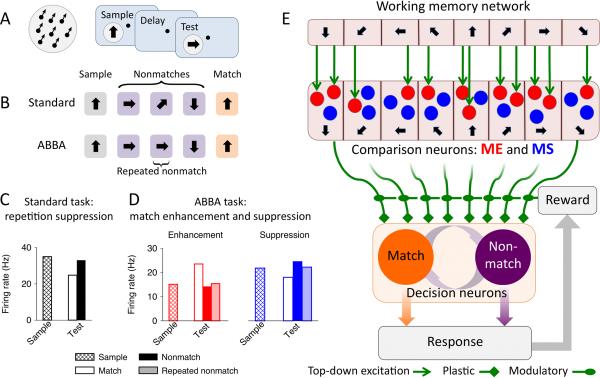Figure 1.
Delayed macth-to-sample task, neural encoding of match/nonmatch and schematic of the circuit model. (A) Left: random dot stimulus. Right: the DMS task. The sample stimulus is followed by a sequence of test stimuli separated by delays. A behavioral response is required if the test matches the sample. (B) Example trials in two versions of the DMS task. In the standard task all intervening nonmatches are different, and the match is the only perceptual stimulus repetition within a trial. In the ABBA task, irrelevant repetitions of nonmatches should be ignored. (C) Repetition suppression in inferior temporal cortex neurons in the standard DMS task (data from Miller et al., 1993). Average responses across cells to the same set of stimuli appearing as a sample, match and nonmatch. (D) Match enhancement and match suppression in two complementary populations of prefrontal cortex neurons in the ABBA task (data from Miller et al., 1996). Average responses across cells to the same set of stimuli appearing as a sample, match, nonmatch and repeated nonmatch. (E) Schematic of the circuit model. Neurons in the working memory (WM) and comparison networks (match enhancement (ME) and suppression (MS) sub-populations) are tuned to directions of motion (indicated by arrows) and receive directional bottom-up input. Top-down projections from the WM to the comparison network are heterogeneous. ME neurons (red circles) receive stronger top-down excitation than MS neurons (blue circles). The decision network (match and nonmatch sub-populations) generates categorical match vs. nonmatch choices by pooling activities of the ME and MS neurons through synapses that undergo reward-dependent Hebbian plasticity.

